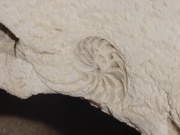Fossils (Inventory)/Cephalopod
From LagWiki
| Line 1: | Line 1: | ||
[[File:Cephalopod1.jpg|thumb|right|Cephalopod fossil]] | [[File:Cephalopod1.jpg|thumb|right|Cephalopod fossil]] | ||
| - | The ''' | + | The '''Cephalopod''' field should be used to list stations which exhibit cephalopod [[Fossils (Inventory)|fossils]]. Cephalopod fossils are characterized by a chambered shell. They are commonly referred to as a ''chambered nautilus'' or ''chambered nautiloid''. The shell could be spiraled or straight. They are usually found in exposed bedrock or breakdown and may be obscured in various ways. They could be covered partially or completely by secondary formations and they could be exposed in any direction or in any cross section. |
If a shell impression is found (not a [[Fossils (Inventory)/Clam|clam]] or [[Fossils (Inventory)/Brachiopod|brachiopod]]) with internal chambers, it is probably a cephalopod. If there are no internal chambers, it is probably a [[Fossils (Inventory)/Gastropod|gastropod]]. Likewise, if the interior of the shell cannot be seen, a shell with logorithmically spaced indications of internal chambers is probably a cephalopod. A shell with a smooth exterior or fine, more evenly spaced growth rings is probably a gastropod. | If a shell impression is found (not a [[Fossils (Inventory)/Clam|clam]] or [[Fossils (Inventory)/Brachiopod|brachiopod]]) with internal chambers, it is probably a cephalopod. If there are no internal chambers, it is probably a [[Fossils (Inventory)/Gastropod|gastropod]]. Likewise, if the interior of the shell cannot be seen, a shell with logorithmically spaced indications of internal chambers is probably a cephalopod. A shell with a smooth exterior or fine, more evenly spaced growth rings is probably a gastropod. | ||
| Line 8: | Line 8: | ||
Cephalopods can leave fossil impressions with no shell. Tentacles like a squid or octopus are the clue to look for. These shell-less impressions are usually hard to recognize and identify, especially in bedrock exposed by dissolution or erosion. | Cephalopods can leave fossil impressions with no shell. Tentacles like a squid or octopus are the clue to look for. These shell-less impressions are usually hard to recognize and identify, especially in bedrock exposed by dissolution or erosion. | ||
| - | + | ==See also== | |
*[[Fossils (Inventory)/Gastropod|Gastropod]] | *[[Fossils (Inventory)/Gastropod|Gastropod]] | ||
| - | + | ||
{{Cave inventory}} | {{Cave inventory}} | ||
| - | |||
[[Category:Needs references]] | [[Category:Needs references]] | ||
Revision as of 00:08, 28 April 2011
The Cephalopod field should be used to list stations which exhibit cephalopod fossils. Cephalopod fossils are characterized by a chambered shell. They are commonly referred to as a chambered nautilus or chambered nautiloid. The shell could be spiraled or straight. They are usually found in exposed bedrock or breakdown and may be obscured in various ways. They could be covered partially or completely by secondary formations and they could be exposed in any direction or in any cross section.
If a shell impression is found (not a clam or brachiopod) with internal chambers, it is probably a cephalopod. If there are no internal chambers, it is probably a gastropod. Likewise, if the interior of the shell cannot be seen, a shell with logorithmically spaced indications of internal chambers is probably a cephalopod. A shell with a smooth exterior or fine, more evenly spaced growth rings is probably a gastropod.
The size of cephalopod fossil impressions can vary greatly.
Cephalopods can leave fossil impressions with no shell. Tentacles like a squid or octopus are the clue to look for. These shell-less impressions are usually hard to recognize and identify, especially in bedrock exposed by dissolution or erosion.
See also

